Finding the best crypto wallets to keep your digital gold secure can feel like an overwhelming task, given the many options available. With the right wallet, your digital assets are safe and easy to manage. With the wrong one, you may risk losing your crypto to hackers.
In this guide, we’ll be covering the best crypto wallets for 2025, looking at both hardware and software options.
We’ll be counting down from #6 to #1, so stick around to find out which takes the top spot for ease of use and versatility!
Best Crypto Wallets — The Top 6 at a Glance
- Tangem Wallet — Pocket-sized cold wallet with a beginner-friendly app
- Ledger Wallet — Popular cold wallet provider with Bluetooth and touchscreen devices
- Cypherock Wallet — Cold wallet with a five-layer key storage for maximum protection
- Margex Wallet — Custodial hot wallet with built-in derivatives and copy trading
- Zengo Wallet — MPC-secured hot wallet for bullet-proof protection against hacks and scams
- Best Wallet — Non-custodial wallet offering access to new tokens before exchange listings
What Is a Crypto Wallet?
They also serve as a gateway to Decentralized Finance (DeFi), NFT storage, and staking rewards, as they can connect to various Web3 apps and services.
Crypto wallets come in various forms; they can be hardware or software (which, in turn, can be mobile apps or web-based). Some are non-custodial, meaning you have full control over your private keys. Others are custodial, where a third party manages your keys.
How Do Crypto Wallets Work?
Crypto wallets store and manage cryptographic keys. Every crypto wallet has a public key and a private key.
A public key is similar to a bank account number – it allows you to receive crypto, and anyone can send you crypto using this number.
The private key is more like a password or PIN, granting you access to your crypto. It’s absolutely vital to keep your private key secret, as anyone who has it is able to get to your funds.
Wallets use these keys to make secure transactions on the blockchain. When you send or buy crypto, your wallet uses the private key to sign off on the transaction, authorizing the payment without exposing the key itself.
Typically, you’ll also have a seed phrase, also known as a recovery phrase, which is a backup for your wallet in case you lose your private key. These are usually 12-24 words long, and once again, if you lose this, you will lose access to your funds.
Types of Crypto Wallets Explained
With so many types of crypto wallets available, the terminology can get confusing. Don’t worry—we’ll break it down.
Which Type of Crypto Wallet Should You Use?
The type of crypto wallet you should use depends on your accessibility needs and security preferences. If you’re a beginner, it’s easier to use a custodial hot wallet like Margex or Binance. They’re straightforward and intuitive, and you can recover your assets easily if you lose access.
If you’re an active day trader or DeFi user, a non-custodial software wallet like Best Wallet or MetaMask is better, as it allows you to have full control of your funds and easily integrates with decentralized applications (dApps).
For long-term HODLers, a hardware wallet is best as it ensures the highest security and peace of mind. For the best of both worlds, it’s worth considering a multi-wallet setup where you have a hot wallet for daily use and a cold wallet for storage.
Best Crypto Wallets in 2025 Reviewed
Choosing the perfect crypto wallet is challenging, but we’ve done all the digging for you.
Here are our top picks for the best crypto wallets today, starting with the best cold wallets for security and moving on to the top hot wallets for accessibility.
6. Tangem Wallet
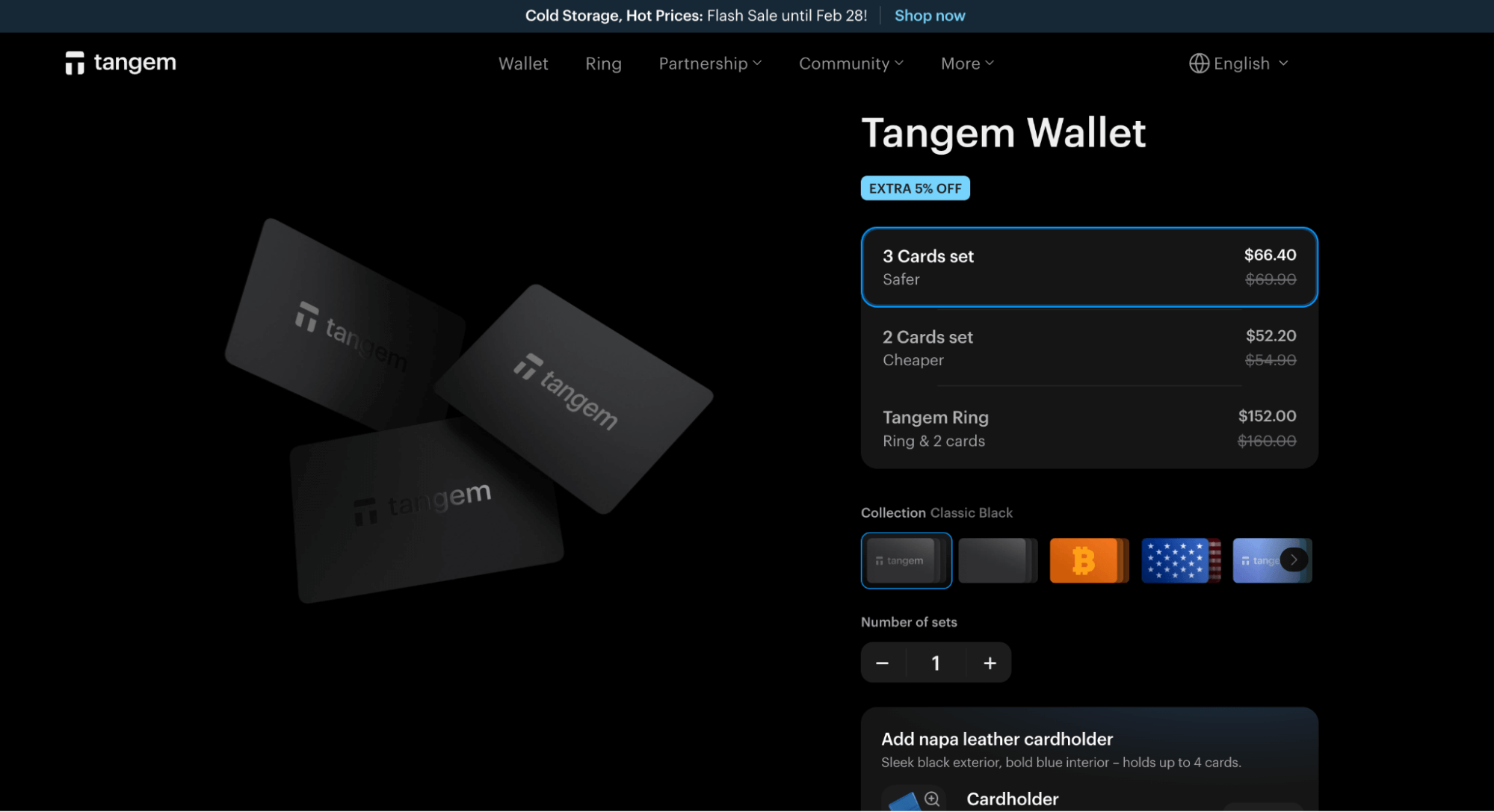
Tangem Wallet is a sleek and unique card-based crypto wallet with a mobile app interface. Your private key is separated across several cards, making your wallet more secure but also compact and easily portable. Not to mention, it’s among the most affordable cold wallets at just $52.20.
The wallet comes as either a two- or three-card set, with the option of adding a wearable ring version. These components act as identical keys (basically giving you several backups).
You only need one card at a time to open your wallet, so you multiply your recovery options (if you happen to lose one). The products also offer the highest resistance to dust, water, and extreme temperatures and come with a 25+ year guarantee.
The wallet also uses Near-Field Communication (NFC) to easily connect to your iOS or Android mobile. It’s super quick to get started, as the setup only takes three minutes.
This makes Tangem suitable for beginners who want a safe cold storage solution without the set-up hassle hardware wallets are sometimes known for.
Despite its simple and minimalist design, it doesn’t skimp on security. This self-custodial wallet boasts an EAL6+ security certification, which is one of the highest in the industry.
When you activate your Tangem Wallet, its chip generates a private key and stores it offline, so you’re not exposed to internet threats. The Tangem device then establishes a secure connection to transfer your encrypted private key and allow you to use the free mobile app.
The app looks and works similarly to a hot wallet, letting you buy, sell, swap, track, and analyze thousands of cryptocurrencies from your phone. You can even stake coins like $ETH to earn passive income on your long-term holdings. Note, this is just an interface for your hardware wallet – your private keys never appear online.
At the time of writing, you can purchase a two-card set for $52.20, a three-card set for $64.40, and the Tangem ring + two cards for $152.00. It’s hard to find better value on the market.
| Tangem Wallet Pros | Tangem Wallet Cons |
|---|---|
|
|
5. Ledger Wallet

Ledger is one of the most popular crypto wallet providers in the market. This French hardware wallet brand has sold over 7M devices in over a decade, advancing from USB-C-only devices (like the Ledger Nano S Plus) to modern devices with Bluetooth and touchscreen, like the Ledger Flex and Ledger Stax.
Currently, Ledger’s full offering includes:
- The Ledger Nano S Plus ($79.00): A digital stick wallet with USB-C connectivity and a small display to verify your transactions.
- The Ledger Nano X ($149.00): A reiteration of the Nano S Plus, which also includes Bluetooth connectivity and iOS compatibility.
- The Ledger Flex ($249.00): A 2.84” wallet with an E-Ink touchscreen display, plus Bluetooth and NFC connectivity.
- The Ledger Stax ($399.00): A 3.7” ledger with a curved E-Ink touchscreen and wireless charging.
The Flex and Stax are the world’s first touchscreen hardware wallets, an innovative spin that makes it easy to review your transactions on the E-ink touchscreen before signing.
Both are powered by the high-speed and secure ST33K1M5 element chip, which is specifically designed to protect sensitive data like your private keys.
For most, forking out for the Flex or Stax isn’t worth it just for a touchscreen. That’s where the more affordable Ledger Nano X and Nano S Plus come in.
The Ledger Nano S Plus is a no-brainer for beginners using an Android or a desktop computer, though it also works via USB-C. Meanwhile, the Ledge Nano X is a mobile-first solution with Bluetooth for everyday use on iOS, Android, and desktops.
All four of Ledger’s solutions integrate directly with the Ledger Live app, which supports 500+ cryptocurrencies, plus Ethereum and Polygon NFTs.
These products are also compatible with 50+ third-party wallets like MetaMask and Guarda Wallet, where you will have even more extensive support for 5,000+ coins and multi-blockchain NFTs.
The accompanying Ledger app is designed with users in mind, aiming to make it easy and safe to exchange crypto. You can readily buy, sell, and track your cryptocurrencies and NFTs, all from within an intuitive dashboard. You can also earn rewards through staking popular coins like $SOL and $ETH.
| Ledger Wallet Pros | Ledger Wallet Cons |
|---|---|
|
|
4. Cypherock Wallet
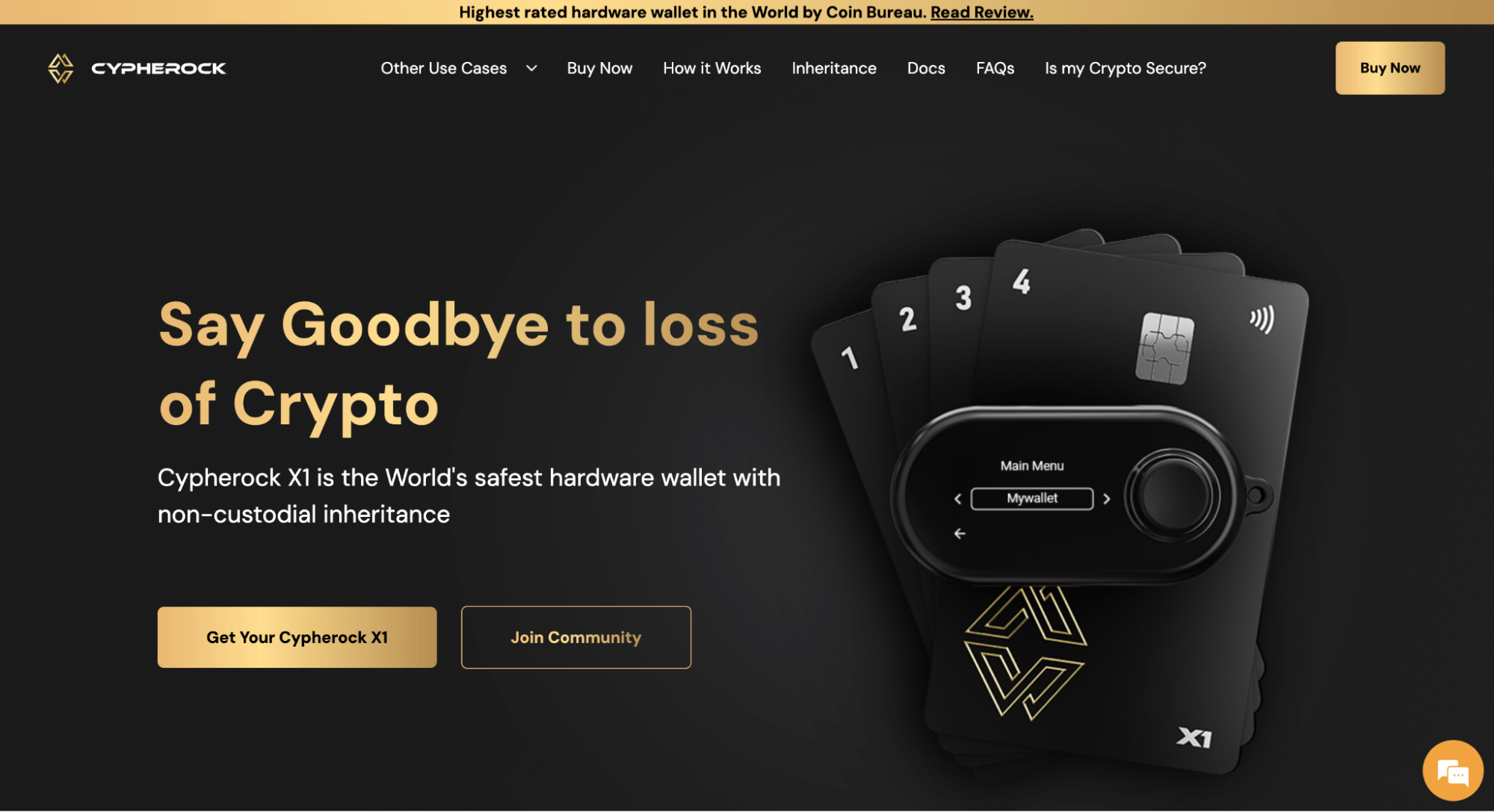
Cypherock is a decentralized hardware wallet that has a unique way of protecting your crypto. It decentralizes your keys by splitting them across five cryptographic parts (four cards and one device) using Shamir’s Secret Sharing (an efficient and secret algorithm for sharing private information).
The five fragments of your key are all stored on their own tamper-proof hardware devices for 10x protection. These devices include four NFC-based credit-card-like devices and a small handheld device with a 5-way joystick.
Fortunately, you only need the handheld device and a card to make transactions. So, losing up to three parts won’t lock you out of your wallet.
You can also set up a PIN on top of your cards. What’s more, you also get multi-wallet management. You can actually create 4 different wallets with one single Cypherock X1. You could have one wallet for your major investments (like $BTC or $ETH), another for NFTs, and one for all other assets, for example.
The Cypherock X1 also integrates with the cySync software (available on Windows, Mac, and Linux). Although the software has no mobile support yet, their roadmap includes adding Android and iOS compatibility.
In cySync, you can buy, sell, and exchange over 9,000 assets on 10 different blockchains, one of the most impressive assets and blockchain supports out of all crypto wallets.
You can even buy crypto coins directly from cySync, as they provide 20 different payment methods in 15 different currencies.
The non-custodial open-source Cypherock X1 crypto wallet will usually cost you $199.00, but they’re currently also running a cold-wallet promotion for only $131.97.
| Cypherock Wallet Pros | Cypherock Wallet Cons |
|---|---|
|
|
3. Margex Wallet
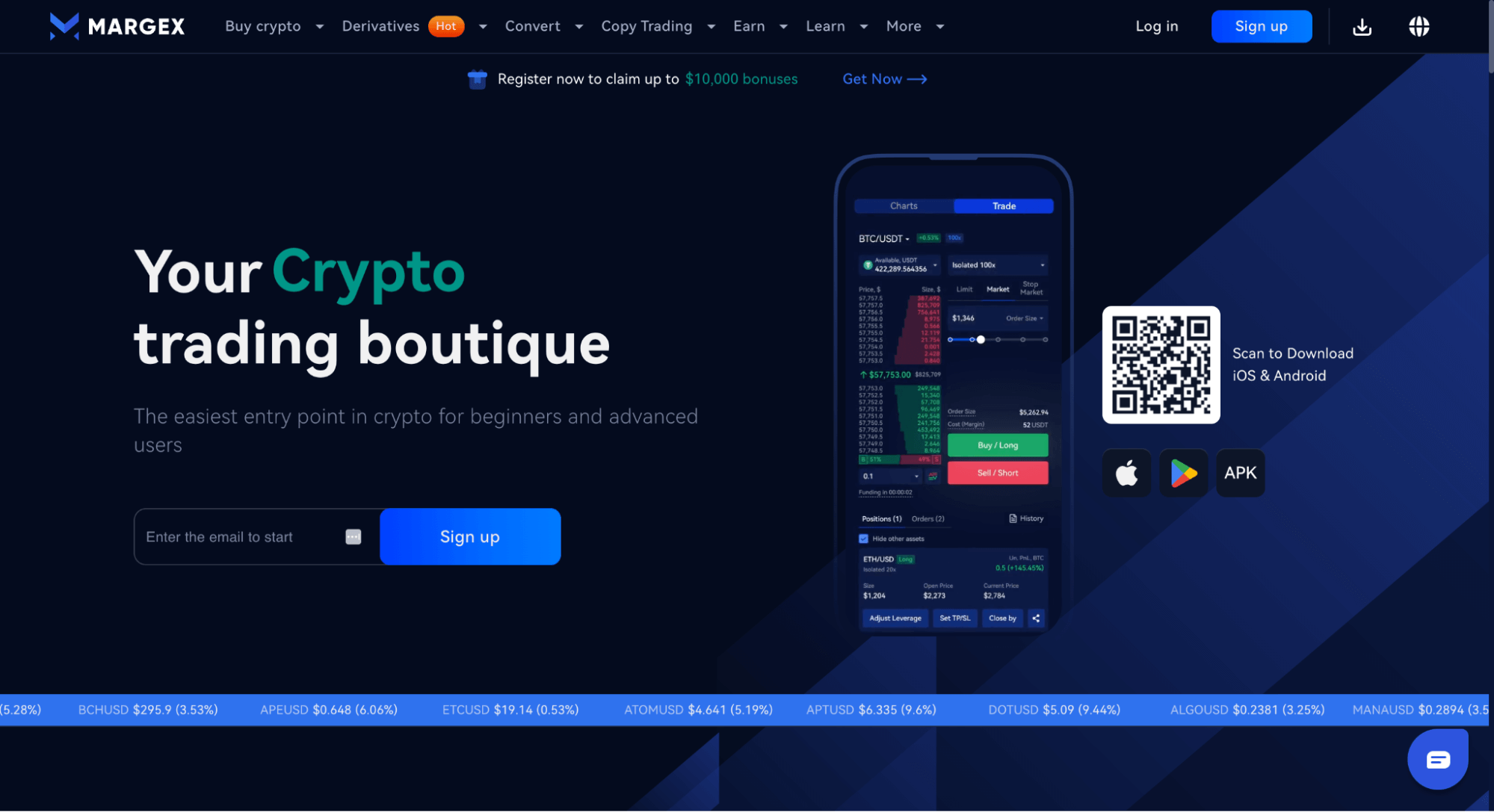
Margex is one of the best wallets for crypto derivatives trading. As it’s an exchange with a native crypto wallet, this makes it a custodial hot wallet. However, Margex stores all your funds in a cold wallet to ensure extra security and to best protect your assets.
Margex is also a non-KYC (know your customer) exchange and wallet. This lets you deposit and withdraw crypto and trade without having to add your ID details. However, KYC is required to deposit or withdraw fiat with a debit or credit card.
Keep in mind that Margex is unavailable in several countries, including the US, Canada, and Hong Kong. But this could change, especially with the new pro-crypto government in the US.
At the time of writing, you can store and trade over 55 assets, including $BTC, $BNB, $DOGE, and more. They offer a new listings tab so you can keep track of any newly added coins.
The wallet is user-friendly and available as an Android or iOS app as well as on desktop browsers, with added 2FA. Not to mention, Margex wallet provides access to an exchange that trumps the other wallets on our list when it comes to crypto management features.
You get plenty of options, from crypto derivatives with up to 100x leverage on perpetual futures to copy trading, where you can mirror trades by experienced investors.
Margex also has some of the most generous staking APYs on the market, with 6% on $BTC and 7% on $ETH, $USDC, and $USDT.
Finally, when you register with Margex, you can win up to $10,000 as a welcome bonus to kickstart your crypto journey with the wallet.
| Margex Wallet Pros | Margex Wallet Cons |
|---|---|
|
|
2. Zengo Wallet
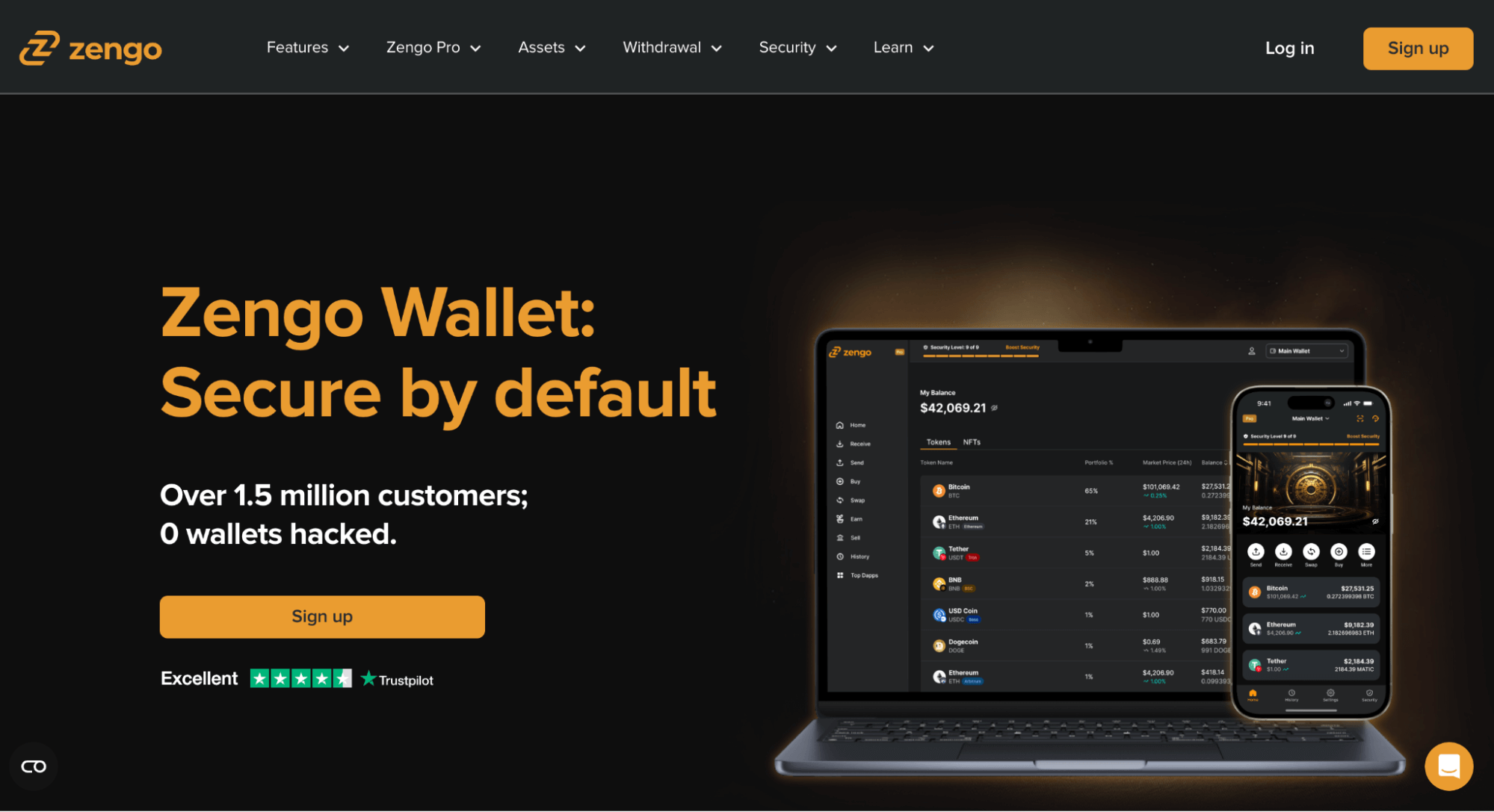
Zengo wallet ditches the usual vulnerable seed phrase and introduces institutional-grade Multi-Party Computation (MPC). This is a type of cryptography used by financial institutions and tech giants, where secret key control is split between two or more parties.
Even if one of the two parties is compromised (your mobile and the Zengo server, for example), your full private key remains secret, and your funds stay safe. Thanks to this, you can store your crypto with peace of mind, knowing you won’t experience hacks or scams.
If that’s not enough security, Zengo adds 3FA for theft protection so that you can always recover your account, and nobody else can authorize transactions on your phone. The 3FA includes email, 3D face lock—essentially a biometric scan—and Zengo file recovery.
Although you don’t know your secret key, the wallet is fully self-custodial. Only you control your funds, and nobody can freeze your account. And if you’re particularly privacy-minded, you also don’t need to fill out KYC to sign up.
Zengo Wallet currently supports over 380 assets and is primarily designed as a phone app but can also be accessed on your desktop.
The hassle-free MPC protection makes Zengo one of the best free crypto wallets to use, albeit you only get basic features like single wallet management, 3FA, and NFT spam filters.
The paid plan, however, lets you create up to 5 wallets to separate your high-value assets from daily flips or public-facing wallets. It also makes Zengo one of the very few, if not the only, providers with a legacy transfer feature.
This feature lets you automatically send your assets to a trusted friend or family member after a period of wallet inactivity. It’s an inheritance-style plan to pass your digital assets over generations, ensuring your assets are never lost, even if your loved ones can’t access your wallet.
To unlock these extra features, you’ll need to sign up for the Zengo Pro option for either $19.99/month or $129.99/year. You can try out Pro with the 3-day free trial; however, you only get this upon signing up for the yearly subscription.
| Zengo Wallet Pros | Zengo Wallet Cons |
|---|---|
|
|
1. Best Wallet
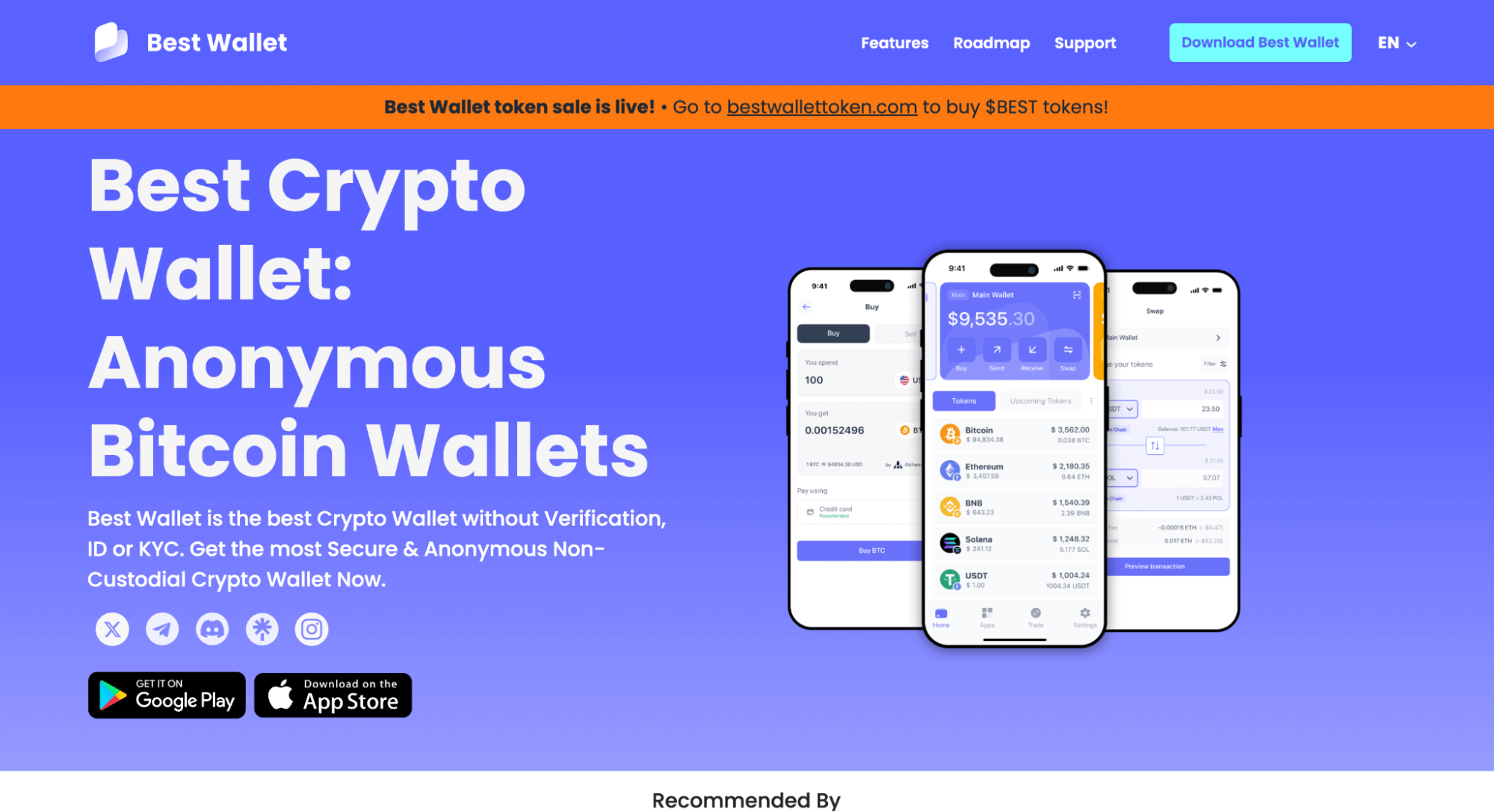
Funnily enough, the top selection on our list is called Best Wallet. But it’s not the best cryptocurrency wallet 2025 in name alone.
Best Wallet is on an ambitious quest to capture 40% of the $11 billion non-custodial wallet market by 2026, and it has the goods to back this up.
Best Wallet currently supports many major chains like $ETH, $BNB, and $BTC, with plans to soon expand to 60+ chains.
You can already effortlessly trade and manage thousands of cryptocurrencies through bridge transactions, but the direct integration of the Bitcoin chain makes this one of the best Bitcoin wallets for lower transaction fees.
The intuitive and lightweight dashboard gives you quick insights into the top and latest trending tokens and overall price trends, so you can buy, sell, and manage your assets with more conviction.
What’s unique about Best Wallet is that it also has an integrated token launchpad. By holding the $BEST token (the wallet’s utility currency), you can access new token launches and buy new coins at pre-market prices. This helps you get the next big crypto at early-bird prices.
You can use Best Wallet for free, or you can purchase the token to gain access to the extra in-app perks like reduced transaction fees and higher staking rewards in the app.
| Best Wallet Pros | Best Wallet Cons |
|---|---|
|
|
How to Use a Crypto Wallet — A Step-by-Step Guide
Whether you pick a hot or cold wallet, the setup process will be similar. For this example, we’ll walk you through the step-by-step process of using Best Wallet.
Step 1: Download Your App (if required)
First, you’ll need to download the Best Wallet app on your mobile phone. You can search for it in the app store on either iOS or Android or scan the QR code on the Best Wallet website.

On the official website, click either of the ‘Buy’ buttons and select the ‘I don’t have a wallet’ option at the bottom of the list. This opens a pop-up window menu with a QR code. Scan this on your phone to install the app.
If your chosen wallet is web-based, you can skip this step.
Step 2: Create Your Account
To create your account, you can use an email address or a Google or Apple account. After selecting any of these, follow the rest of the account setup steps.

You’ll need to create an app passcode to add an extra layer of security. You can also select to add 2FA, fingerprint, or Face ID scans.
Finally, you can enable push notifications to receive important updates. After this, your first wallet is already generated and ready for use!
Step 3: Fund Your Crypto Wallet
Before you’re able to buy, sell, or swap crypto assets, you’ll need to fund your wallet. You can do this in two ways.
The first is using the on-ramping feature to buy crypto directly in-app using a bank card.
Let’s say you want to buy $SOL. Tap the ‘buy’ button at the top of your dashboard and select Solana in the crypto dropdown menu. Best Wallet automatically chooses the fiat payment currency based on your region, but you can also change this.

Type in how much you want to spend. The app automatically gives you the equivalent amount in $SOL and which payment platforms offer the best price.
Select the payment dropdown menu and choose one of the payment options. These include Debit Card, Revolut, Google Pay, Neteller, and more. Finally, hit ‘Buy’ and fill in your payment details to confirm your transaction.
Remember that buying most crypto will mean you have ‘gas fees,’ so you must have extra money to cover these. Gas fees are low on $SOL, but for coins like $ETH, they can be a lot.
The second option is to fund your wallet by receiving crypto from another address.
To do so, tap the ‘Receive’ button at the top of your dashboard and get the right public address for the token you wish to deposit. If it’s $ETH, for example, then get the Ethereum chain address of your Best Wallet.

This address is where you or your friends can send crypto to fund your wallet. After someone sends you crypto to this address, you’ll have $ETH inside your Best Wallet, which you can use to buy or swap other assets.
How We Worked Out Which Are the Best Crypto Wallets
To be able to put this list together, we evaluated each of our top 6 wallets in terms of:
- Supported cryptocurrencies — We want to make sure the wallets support a suitable range of assets. All should cover major ones like $BTC or $ETH at the very least, but we like the additions of altcoins, stablecoins, and meme coins to diversify your holdings.
- Direct exchange integration — We prefer wallets that let you buy, sell, and swap your crypto directly on the app or device. If you need to transfer your funds to an external exchange, it can be time-consuming, and you may miss selling at your price target.
- Security — Of course, with crypto wallets, security is of utmost importance. We look extensively into each wallet’s encryption standards, whether they offer MFA or 2FA, and how recently they have had their security audited.
- Mobile apps — Although not all wallets on our list have mobile apps (yet), this is important for seamless portfolio tracking and making swaps on the go.
- Reputation — We always dig deep under the covers to read what users are saying about the product. Whether it’s reading reviews on TrustPilot and the App stores or scouring Reddit for threads, we make sure each wallet has a solid reputation with users.
Closing Our Best Crypto Wallets Review
Now that we’ve ranked the best crypto wallets, you should have a good idea of what to look for in the market. We’ve covered the differences between hot vs cold, and custodial vs non-custodial wallets to give you the insights you need to make an informed decision.
The best crypto wallet for you depends on your security needs, convenience, and how often you wish to trade or HODL crypto. But remember, no wallet is 100% risk-free. You should do your best to secure your seed phrase and use all possible extra layers of security just in case.
This blog is not financial advice. Please DYOR before you choose a wallet to ensure it aligns with your needs and tolerance for risk.
Frequently Asked Questions About the Best Crypto Wallets
1. What is a crypto wallet?
A crypto wallet is a tool that stores your private and public keys, allowing you to send, receive, and manage your cryptocurrencies. Wallets can be hot (online) or cold (offline) and either custodial (third-party controlled) or non-custodial (controlled by you).
2. What are the best crypto wallets?
The best crypto wallet today depends on your needs. If you want a hardware wallet, then Tangem, Ledger, and Cypherock offer unbeatable security. Meanwhile, Zengo, Best Wallet, and Margex are ideal hot wallets for ease of use and day trading. You should also consider supported assets and how your private keys are managed.
3. What is the best crypto cold wallet?
The best crypto cold wallet today would be either Tangem, Ledger, or Cypherrock, depending on your experience level and security needs. Tangem is an affordable wallet with EAL6+ security and no need for charging. Ledger Nano X is an industry leader with Bluetooth connectivity and on-display signing. Cypherock X1 offers an advanced multi-backup system with split private key storage.
4. Which crypto wallet has the lowest fees?
Non-custodial wallets generally have no fees, while exchange wallets (custodial) usually charge withdrawal fees. Note that gas fees apply in all wallets, as these fees are necessary to validate blockchain transactions. With this in mind, Tangem Wallet offers standard blockchain gas fees, while Best Wallet offers lower-cost transactions if you hold the $BEST token.
5. Which crypto wallet is the safest?
Cold wallets like Tangem Wallet, Ledger, and Cypherock are the safest because they store your private keys offline, away from hackers. Zengo Wallet goes a step further by using MPC (multi-party computation) to offer bullet-proof security from hackers and scams—you don’t even have a seed phrase to worry about.
6. What is the best crypto wallet for beginners?
Tangem Wallet is perfect for beginners as it’s a pocket-sized crypto wallet that you can set up in under three minutes. Best Wallet also has a user-friendly design. The best crypto wallet app for beginners should be easy to set up, secure, and user-friendly. Look for a simple onboarding process along with strong security features.










































